Wenxiong Kang
M3DHMR: Monocular 3D Hand Mesh Recovery
May 26, 2025Abstract:Monocular 3D hand mesh recovery is challenging due to high degrees of freedom of hands, 2D-to-3D ambiguity and self-occlusion. Most existing methods are either inefficient or less straightforward for predicting the position of 3D mesh vertices. Thus, we propose a new pipeline called Monocular 3D Hand Mesh Recovery (M3DHMR) to directly estimate the positions of hand mesh vertices. M3DHMR provides 2D cues for 3D tasks from a single image and uses a new spiral decoder consist of several Dynamic Spiral Convolution (DSC) Layers and a Region of Interest (ROI) Layer. On the one hand, DSC Layers adaptively adjust the weights based on the vertex positions and extract the vertex features in both spatial and channel dimensions. On the other hand, ROI Layer utilizes the physical information and refines mesh vertices in each predefined hand region separately. Extensive experiments on popular dataset FreiHAND demonstrate that M3DHMR significantly outperforms state-of-the-art real-time methods.
SplatCo: Structure-View Collaborative Gaussian Splatting for Detail-Preserving Rendering of Large-Scale Unbounded Scenes
May 23, 2025Abstract:We present SplatCo, a structure-view collaborative Gaussian splatting framework for high-fidelity rendering of complex outdoor environments. SplatCo builds upon two novel components: (1) a cross-structure collaboration module that combines global tri-plane representations, which capture coarse scene layouts, with local context grid features that represent fine surface details. This fusion is achieved through a novel hierarchical compensation strategy, ensuring both global consistency and local detail preservation; and (2) a cross-view assisted training strategy that enhances multi-view consistency by synchronizing gradient updates across viewpoints, applying visibility-aware densification, and pruning overfitted or inaccurate Gaussians based on structural consistency. Through joint optimization of structural representation and multi-view coherence, SplatCo effectively reconstructs fine-grained geometric structures and complex textures in large-scale scenes. Comprehensive evaluations on 13 diverse large-scale scenes, including Mill19, MatrixCity, Tanks & Temples, WHU, and custom aerial captures, demonstrate that SplatCo consistently achieves higher reconstruction quality than state-of-the-art methods, with PSNR improvements of 1-2 dB and SSIM gains of 0.1 to 0.2. These results establish a new benchmark for high-fidelity rendering of large-scale unbounded scenes. Code and additional information are available at https://github.com/SCUT-BIP-Lab/SplatCo.
EA-3DGS: Efficient and Adaptive 3D Gaussians with Highly Enhanced Quality for outdoor scenes
May 16, 2025Abstract:Efficient scene representations are essential for many real-world applications, especially those involving spatial measurement. Although current NeRF-based methods have achieved impressive results in reconstructing building-scale scenes, they still suffer from slow training and inference speeds due to time-consuming stochastic sampling. Recently, 3D Gaussian Splatting (3DGS) has demonstrated excellent performance with its high-quality rendering and real-time speed, especially for objects and small-scale scenes. However, in outdoor scenes, its point-based explicit representation lacks an effective adjustment mechanism, and the millions of Gaussian points required often lead to memory constraints during training. To address these challenges, we propose EA-3DGS, a high-quality real-time rendering method designed for outdoor scenes. First, we introduce a mesh structure to regulate the initialization of Gaussian components by leveraging an adaptive tetrahedral mesh that partitions the grid and initializes Gaussian components on each face, effectively capturing geometric structures in low-texture regions. Second, we propose an efficient Gaussian pruning strategy that evaluates each 3D Gaussian's contribution to the view and prunes accordingly. To retain geometry-critical Gaussian points, we also present a structure-aware densification strategy that densifies Gaussian points in low-curvature regions. Additionally, we employ vector quantization for parameter quantization of Gaussian components, significantly reducing disk space requirements with only a minimal impact on rendering quality. Extensive experiments on 13 scenes, including eight from four public datasets (MatrixCity-Aerial, Mill-19, Tanks \& Temples, WHU) and five self-collected scenes acquired through UAV photogrammetry measurement from SCUT-CA and plateau regions, further demonstrate the superiority of our method.
AS3D: 2D-Assisted Cross-Modal Understanding with Semantic-Spatial Scene Graphs for 3D Visual Grounding
May 07, 2025Abstract:3D visual grounding aims to localize the unique target described by natural languages in 3D scenes. The significant gap between 3D and language modalities makes it a notable challenge to distinguish multiple similar objects through the described spatial relationships. Current methods attempt to achieve cross-modal understanding in complex scenes via a target-centered learning mechanism, ignoring the perception of referred objects. We propose a novel 2D-assisted 3D visual grounding framework that constructs semantic-spatial scene graphs with referred object discrimination for relationship perception. The framework incorporates a dual-branch visual encoder that utilizes 2D pre-trained attributes to guide the multi-modal object encoding. Furthermore, our cross-modal interaction module uses graph attention to facilitate relationship-oriented information fusion. The enhanced object representation and iterative relational learning enable the model to establish effective alignment between 3D vision and referential descriptions. Experimental results on the popular benchmarks demonstrate our superior performance compared to state-of-the-art methods, especially in addressing the challenges of multiple similar distractors.
Pseudo-label Refinement for Improving Self-Supervised Learning Systems
Oct 18, 2024



Abstract:Self-supervised learning systems have gained significant attention in recent years by leveraging clustering-based pseudo-labels to provide supervision without the need for human annotations. However, the noise in these pseudo-labels caused by the clustering methods poses a challenge to the learning process leading to degraded performance. In this work, we propose a pseudo-label refinement (SLR) algorithm to address this issue. The cluster labels from the previous epoch are projected to the current epoch cluster-labels space and a linear combination of the new label and the projected label is computed as a soft refined label containing the information from the previous epoch clusters as well as from the current epoch. In contrast to the common practice of using the maximum value as a cluster/class indicator, we employ hierarchical clustering on these soft pseudo-labels to generate refined hard-labels. This approach better utilizes the information embedded in the soft labels, outperforming the simple maximum value approach for hard label generation. The effectiveness of the proposed SLR algorithm is evaluated in the context of person re-identification (Re-ID) using unsupervised domain adaptation (UDA). Experimental results demonstrate that the modified Re-ID baseline, incorporating the SLR algorithm, achieves significantly improved mean Average Precision (mAP) performance in various UDA tasks, including real-to-synthetic, synthetic-to-real, and different real-to-real scenarios. These findings highlight the efficacy of the SLR algorithm in enhancing the performance of self-supervised learning systems.
4DStyleGaussian: Zero-shot 4D Style Transfer with Gaussian Splatting
Oct 14, 2024Abstract:3D neural style transfer has gained significant attention for its potential to provide user-friendly stylization with spatial consistency. However, existing 3D style transfer methods often fall short in terms of inference efficiency, generalization ability, and struggle to handle dynamic scenes with temporal consistency. In this paper, we introduce 4DStyleGaussian, a novel 4D style transfer framework designed to achieve real-time stylization of arbitrary style references while maintaining reasonable content affinity, multi-view consistency, and temporal coherence. Our approach leverages an embedded 4D Gaussian Splatting technique, which is trained using a reversible neural network for reducing content loss in the feature distillation process. Utilizing the 4D embedded Gaussians, we predict a 4D style transformation matrix that facilitates spatially and temporally consistent style transfer with Gaussian Splatting. Experiments demonstrate that our method can achieve high-quality and zero-shot stylization for 4D scenarios with enhanced efficiency and spatial-temporal consistency.
ControLRM: Fast and Controllable 3D Generation via Large Reconstruction Model
Oct 12, 2024



Abstract:Despite recent advancements in 3D generation methods, achieving controllability still remains a challenging issue. Current approaches utilizing score-distillation sampling are hindered by laborious procedures that consume a significant amount of time. Furthermore, the process of first generating 2D representations and then mapping them to 3D lacks internal alignment between the two forms of representation. To address these challenges, we introduce ControLRM, an end-to-end feed-forward model designed for rapid and controllable 3D generation using a large reconstruction model (LRM). ControLRM comprises a 2D condition generator, a condition encoding transformer, and a triplane decoder transformer. Instead of training our model from scratch, we advocate for a joint training framework. In the condition training branch, we lock the triplane decoder and reuses the deep and robust encoding layers pretrained with millions of 3D data in LRM. In the image training branch, we unlock the triplane decoder to establish an implicit alignment between the 2D and 3D representations. To ensure unbiased evaluation, we curate evaluation samples from three distinct datasets (G-OBJ, GSO, ABO) rather than relying on cherry-picking manual generation. The comprehensive experiments conducted on quantitative and qualitative comparisons of 3D controllability and generation quality demonstrate the strong generalization capacity of our proposed approach.
Improving 3D Finger Traits Recognition via Generalizable Neural Rendering
Oct 12, 2024Abstract:3D biometric techniques on finger traits have become a new trend and have demonstrated a powerful ability for recognition and anti-counterfeiting. Existing methods follow an explicit 3D pipeline that reconstructs the models first and then extracts features from 3D models. However, these explicit 3D methods suffer from the following problems: 1) Inevitable information dropping during 3D reconstruction; 2) Tight coupling between specific hardware and algorithm for 3D reconstruction. It leads us to a question: Is it indispensable to reconstruct 3D information explicitly in recognition tasks? Hence, we consider this problem in an implicit manner, leaving the nerve-wracking 3D reconstruction problem for learnable neural networks with the help of neural radiance fields (NeRFs). We propose FingerNeRF, a novel generalizable NeRF for 3D finger biometrics. To handle the shape-radiance ambiguity problem that may result in incorrect 3D geometry, we aim to involve extra geometric priors based on the correspondence of binary finger traits like fingerprints or finger veins. First, we propose a novel Trait Guided Transformer (TGT) module to enhance the feature correspondence with the guidance of finger traits. Second, we involve extra geometric constraints on the volume rendering loss with the proposed Depth Distillation Loss and Trait Guided Rendering Loss. To evaluate the performance of the proposed method on different modalities, we collect two new datasets: SCUT-Finger-3D with finger images and SCUT-FingerVein-3D with finger vein images. Moreover, we also utilize the UNSW-3D dataset with fingerprint images for evaluation. In experiments, our FingerNeRF can achieve 4.37% EER on SCUT-Finger-3D dataset, 8.12% EER on SCUT-FingerVein-3D dataset, and 2.90% EER on UNSW-3D dataset, showing the superiority of the proposed implicit method in 3D finger biometrics.
EmoFace: Emotion-Content Disentangled Speech-Driven 3D Talking Face with Mesh Attention
Aug 21, 2024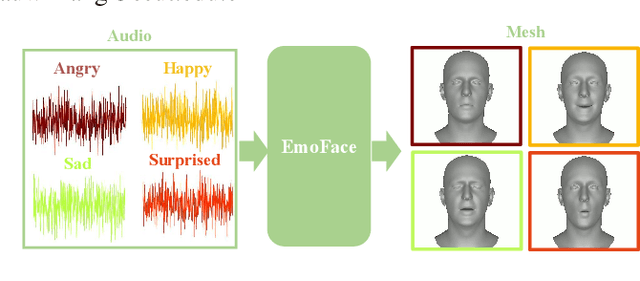
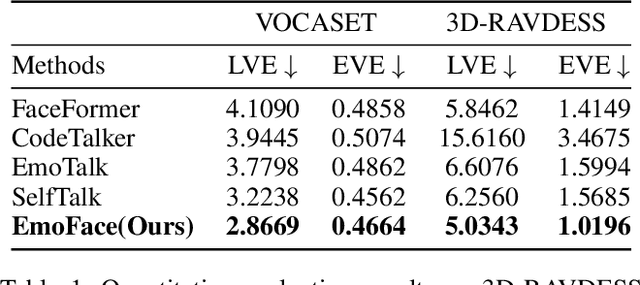
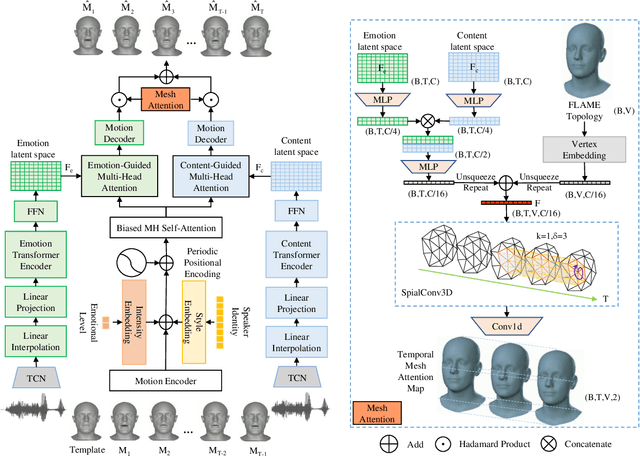

Abstract:The creation of increasingly vivid 3D virtual digital humans has become a hot topic in recent years. Currently, most speech-driven work focuses on training models to learn the relationship between phonemes and visemes to achieve more realistic lips. However, they fail to capture the correlations between emotions and facial expressions effectively. To solve this problem, we propose a new model, termed EmoFace. EmoFace employs a novel Mesh Attention mechanism, which helps to learn potential feature dependencies between mesh vertices in time and space. We also adopt, for the first time to our knowledge, an effective self-growing training scheme that combines teacher-forcing and scheduled sampling in a 3D face animation task. Additionally, since EmoFace is an autoregressive model, there is no requirement that the first frame of the training data must be a silent frame, which greatly reduces the data limitations and contributes to solve the current dilemma of insufficient datasets. Comprehensive quantitative and qualitative evaluations on our proposed high-quality reconstructed 3D emotional facial animation dataset, 3D-RAVDESS ($5.0343\times 10^{-5}$mm for LVE and $1.0196\times 10^{-5}$mm for EVE), and publicly available dataset VOCASET ($2.8669\times 10^{-5}$mm for LVE and $0.4664\times 10^{-5}$mm for EVE), demonstrate that our algorithm achieves state-of-the-art performance.
GLDiTalker: Speech-Driven 3D Facial Animation with Graph Latent Diffusion Transformer
Aug 03, 2024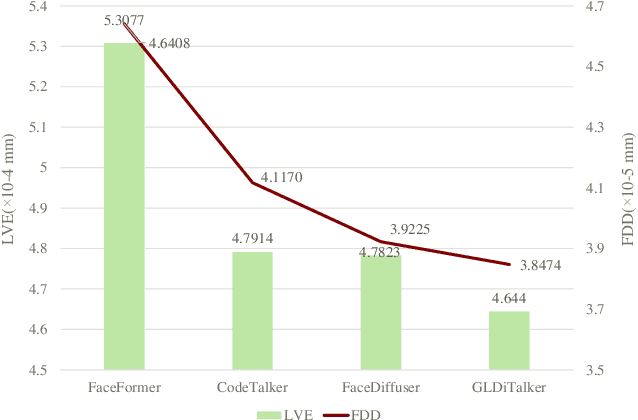

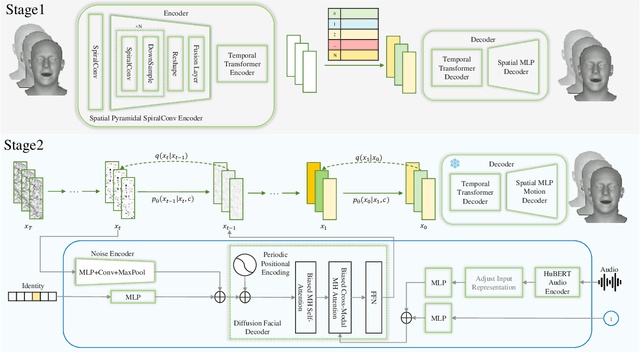
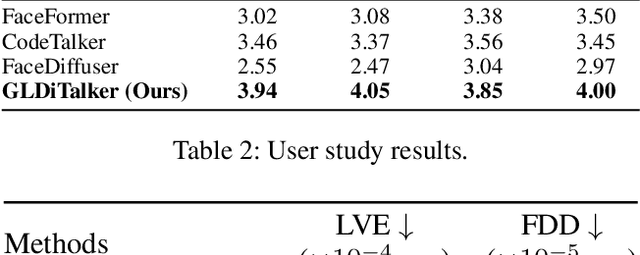
Abstract:3D speech-driven facial animation generation has received much attention in both industrial applications and academic research. Since the non-verbal facial cues that exist across the face in reality are non-deterministic, the generated results should be diverse. However, most recent methods are deterministic models that cannot learn a many-to-many mapping between audio and facial motion to generate diverse facial animations. To address this problem, we propose GLDiTalker, which introduces a motion prior along with some stochasticity to reduce the uncertainty of cross-modal mapping while increasing non-determinacy of the non-verbal facial cues that reside throughout the face. Particularly, GLDiTalker uses VQ-VAE to map facial motion mesh sequences into latent space in the first stage, and then iteratively adds and removes noise to the latent facial motion features in the second stage. In order to integrate different levels of spatial information, the Spatial Pyramidal SpiralConv Encoder is also designed to extract multi-scale features. Extensive qualitative and quantitative experiments demonstrate that our method achieves the state-of-the-art performance.
 Add to Chrome
Add to Chrome Add to Firefox
Add to Firefox Add to Edge
Add to Edge